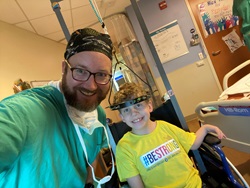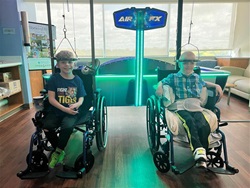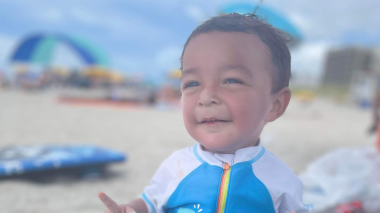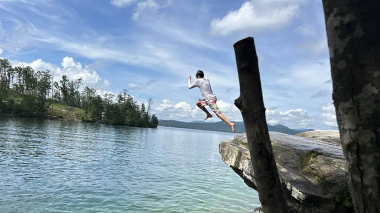Brayden Shiflett’s parents, Megan and Cody, say he’s an active eight-year-old who enjoys throwing a football and playing with his younger siblings, Sadie and Jackson.
“He’s a blast to be around,” Megan says. “He always has the best attitude and enjoys making people smile,” Megan says.
But Brayden’s positive spirit takes on a deeper meaning when you understand all he has endured in his first eight years of life. With a little help from his team of experts at Atrium Health Levine Children’s Hospital, a Best Children’s Hospital for pediatric orthopedics according to U.S. News & World Report, Brayden’s positive outlook has helped him overcome some tough times.
A miracle at birth
When Megan was pregnant, she was told that Brayden had a complex congenital heart defect called tetralogy of Fallot (TOF), which affects normal blood flow through the heart. TOF can typically be treated with several surgeries, the first taking place soon after the baby is delivered.
Megan says she went to a hospital near Winston-Salem when she was 37 weeks pregnant because something didn’t feel right. She was admitted and induced and Brayden was born three days later – but he didn’t take his first breath right away.
“I was just laying there wondering why I couldn't hear my baby,” Megan says. “They almost pronounced him as gone. But then, out of nowhere, he took one single gasp.”
Brayden was taken to the neonatal intensive care unit (NICU) for further care. Megan and Cody were preparing themselves for an update about his heart defect. But they got some more surprising news about their newborn boy: Brayden only had four ribs, which were fused together to his spine, and he had severe scoliosis.
Over his first two weeks in the NICU, Brayden was diagnosed with multiple conditions. But it wasn't until a few weeks later that Megan and Cody started to learn more about the complexity of their son’s condition.
In addition to TOF, Brayden was diagnosed with VACTERL association, a cluster of birth defects that occur as the baby is developing in their mother’s womb. Symptoms of VACTERL typically appear at birth or soon after the baby is born.
The acronym seems intimidating, but it stands for the first letter of each part of the body that may be affected: Vertebrae; Anal atresia; Cardiac; Trachea; Esophagus; Renal and/or Radial; and Limbs. A diagnosis occurs if at least three body parts are affected by symptoms.
In Brayden’s case, VACTERL was diagnosed based on his spine, heart condition and limbs.
Game-changing treatment
As Brayden grew, so did his care team. His family began to travel to Charlotte to seek treatment for his heart condition. During one of Brayden’s cardiology checkups at Levine Children’s in January 2022, Megan mentioned to his provider that they needed someone to help treat his scoliosis. The cardiologist put them in touch with Dr. Brian Brighton, a pediatric orthopedic surgeon with Levine Children’s. 
After meeting with Brayden and Megan, Brighton recommended Brayden receive a procedure called halo traction to help prepare his spine for surgery to correct his scoliosis. This unique treatment places a metal ring around the head that is held in place with pins. The halo is attached to weights that are hung off a bed, wheelchair, or a walker. The weights work with the halo to slowly pull the head upward, gently straightening the spine. This treatment is typically reserved for severely curved spines. Once Brayden’s halo treatment was complete, he had another surgery to remove the halo and pins, and place magnetic lengthening rods on both sides of his spine to hold his spine straight. These rods are used in children who still have significant growing to do, since the entire spine can’t be fused until they are fully grown. During this surgery, Brayden’s team also removed a vertebra that had turned and caused a bump on Brayden’s back.
Megan says one welcomed side effect of straightening out Brayden’s spine is that Brayden’s eating and digestion have improved dramatically.
“Now his body is stretching out and giving his stomach more room, so his appetite has improved and he’s not bloating when he eats,” Megan says.
Best friends for life
Halo traction can be painful, and especially isolating since kids have to remain in the hospital for multiple weeks during their halo traction treatment. For Brayden, the adjustment was understandably difficult. But then he met his new BFF.
Five-year-old Jameson Woods went in for his halo traction surgery on the same day as Brayden. They met a few days after their surgeries in the game room at Levine Children’s Hospital and immediately hit it off.
“I think it really helped Brayden to know he wasn’t the only one going through this,” Megan says. “If he had been by himself the whole time, this would have been a very depressing time for him. But having Jameson go through this together gave Brayden motivation – and we all became one big family at the hospital.”
The boys grew close in the weeks they were in the hospital – eating meals together, challenging each other to air hockey and basketball games and playing video games together to pass the time. They bonded over their challenges and celebrated their victories. But finding out they each had a brother named Jackson really solidified their connection.When it was time for Jameson to return home, the boys were sad to say goodbye. But their families traded numbers and they continue to stay in touch today. They are even trying to coordinate their follow-up appointments so they can reunite in person again soon.
Not just a number
Megan says one of the things that meant the most to them about the care Brayden has received at Levine Children’s is the constant reminder that he is more than a patient.
“Each person we came in contact with went above and beyond to make Brayden feel special and seen,” Megan says. “Levine Children’s isn’t just top-tier treatment, it’s compassionate care at every level.”
Megan recalls when they first met Brighton and he was talking to them about the upcoming halo traction surgery.
“Brayden was very scared and started to cry,” Megan says. “Dr. Brighton could see how scared Brayden was and he promised Brayden that he would take the very best care of him. That’s when I knew these people truly care about Brayden and I knew he deeply cared about him.”
Brayden’s night nurse, Jarren Crescitelli, also played a special part in his treatment. Megan says Crescitelli always took the time to ask how Brayden was doing.
“One time Brayden asked her about the penguin charm on her bracelet and she told him it represented a real animal she could track using an app on her phone,” Megan says. “She showed the real penguin to Brayden on her phone and asked him to pick out an animal he wanted to track. Then she surprised him with a bracelet so they could track their animals together. It meant so much that she went out of her way to bond with him.”
Navigating the future
Brayden will have a follow-up appointment with Brighton to check on his scars from the surgery. He will also have office visits to lengthen the rods in his back every 4-6 months for the next few years. Since the rods can only be lengthened a certain amount each time, he may need to trade them out for a larger set as he continues to grow. After puberty, Brayden will have another surgery, called a definitive spinal fusion, to remove the lengthening rods and fuse his bones together in their more permanent position.
As Brayden continues to navigate this chapter of his life, his parents want to empower him to remain curious and try new things. He still enjoys throwing the football and playing with his siblings, and continues to find ways to bring sunshine and humor to those around him.“We never want Brayden to feel limited in what he can do,” Megan says. “It may be a different way than someone else would do it, but he can do it. And we’re excited to watch him go after whatever he wants in life.”
See more lives that were changed by Levine Children's.



